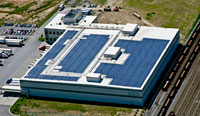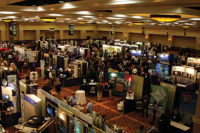Cold food plants, warehouses can reap solar energy savings in the right situations.

by Chris Walmsley
Solar is clean. Solar is subsidized. Solar reduces operating costs. Bingo. The bottom line. Without a positive impact to the bottom line, solar or any renewable energy source would have a hard time remaining a sustainable business worldwide.
Macro forces are at work behind the scenes. Major corporations like Google and Wal-Mart are demonstrating corporate responsibility, environmental stewardship and responding to consumer demand by going solar, but not unless it makes sound financial sense.
At the federal and state level, the political will is responding to the call to protect U.S. energy security by subsidizing renewable energy - like solar, wind and biofuels – energy sources that don’t rely on foreign controlled raw materials. Catastrophes like the BP Oil spill and Japan's Fukushima Daiichi nuclear plant disaster reinforce this will to diversify the U.S. energy portfolio.
Energy options, costs
Government subsidies for energy are hardly new. Most Americans would be surprised to learn that the mature oil and gas, coal and nuclear industries still receive government subsidies – more than 70 percent of all federal energy subsidies between 2002 and 2008, as reported by the Environmental Law Institute. There are good reasons for this. Energy is vital to our way of life. All forms of energy need to be protected, diversified and supported.
The economic DNA of solar is made up of government subsidies, the price for competing electricity supply and the cost to install solar energy systems. The economic DNA of solar is strong.
In 2008, the federal government renewed the solar investment tax credit of 30 percent based on the installed cost of a solar energy system and extended this tax credit for 8 years through 2016 – a solid foundation of support for solar. Many, but not all states also support solar in various ways – from state investment tax credits to renewable portfolio standards for investor-owned utilities that result in Solar Renewable Energy Credit (SREC) markets. For example, recently in Ohio, a megawatt hour of solar energy sold through an SREC exchange for $400. So, imagine the value added to a solar energy system that generates thousands of megawatt hours a year for over 25 years. And that is on top of the value of the electricity consumed by the system owner or net metered onto the grid.
Despite a temporary softening of electricity prices in 2009 (as a result of a global recession and the discovery of the Marcellus Shale natural gas reserves) over the previous 40 years, US average commercial electricity prices have increased each year by over 3.6 percent according to the EIA. Prices went back up in 2010, too. And few will disagree that the demand for electricity only continues to grow as we use more and more electronics at home and at work. Think iPods, digital cameras, laptops, cell phones, cable boxes. Or try keeping up with your teenager’s myriad of chargers for this device or that device. And then add electric cars to the mix. They are coming.
Demand is just part of the electricity picture, though. Across the United States -- from state to state -- the supply of electricity is inconsistent. It is abundant and cheap in some states and challenged and expensive in others. In coal country, in states like West Virginia, Virginia, Pennsylvania and North Carolina, electricity is inexpensive. Commercial customers might pay between 5 and 10 cents per kilowatt hour, but not so in the Northeast or California, more like 15 to 20 cents. And then there is Hawaii: 25 cents per kilowatt hour.
The strongest part of solar’s economic DNA, though, is the human capacity to innovate, improve efficiency and drive down costs. The average cost to install commercial scale solar has been cut in half in the last 3 years. Close your eyes and imagine a flat roof of about 125,000 square feet covered with solar panels – that’s about 1 megawatt, and the cost has dropped from about $8M to about $4M.
This is the key. Whether you believe the government should subsidize the energy industry or that electricity prices will continue to rise, the fact is, the efficiency of solar technology is improving and the cost to install it is coming down. Competition “drove down the price of solar panels by 30 percent since the beginning of 2010,” alone said Rhone Resch, President of the Solar Energy Industries Association, “This is good news for residential and business customers as solar becomes more affordable every day.”
Grid parity – the unsubsidized cost of solar versus the unsubsidized cost of another form of electricity – is on the horizon and already there in some states.
Solar energy roots first in states where electricity prices are high and/or state solar subsidies are strongest, states like CA, NJ, MA, MD, OH and others. The Refrigerated and Frozen Foods industry counts itself as an early adopter of solar, and for good reasons. Building owners have large, flat rooftops and the facilities tend to be purpose built. With blast freezers and refrigeration, operators are sophisticated energy buyers and tend to consume tremendous kilowatt hours, especially during peak demand hours when the sun is sitting highest in the sky.
Add creditworthiness and a long-term view of capital assets to the profile of these business owners, and solar makes good financial sense all around. MTC Logistics (www.mtccold.com), Hall’s Warehouse Corp. (www.hallscorp.com), Henningsen Cold Storage Co. (www.henningsen.com) to name a few.
Is solar right for you?
Okay, here is the trick. Is solar right for me and right for me now? First let’s consider a basic set of questions that determine if a solar opportunity even exists:
• Where is my facility located? What state? What state subsidies exist?
• Do I own the facility or lease it?
• How many kilowatt hours of electricity does my facility use annually?
• How large is my roof, parking lot or available acreage?
• How old is my roof? When does the warranty expire?
• How cluttered is my roof? Does my land have permitting hurdles like wetlands?
• Is my business credit worthy?
• Do I have capital to invest? Do I have a strong enough tax appetite?
• Will my property be here in 20 years or will it be repurposed and redeveloped?
Answers to the questions like those above will determine if a solar opportunity exists and help guide business owners to answer the “How” of going solar. So, the “How”. Two avenues stretch out before business owners – Host or Buy:
1. Savings or Revenue: Host a solar energy system on your property and buy the electricity from the system owner at a discount to your current electric rates or lease your property (roof or land) to the system owner and earn revenue from lease payments.
2. Investment & Savings: Buy or lease a solar energy system and install it on your property to take advantage of a strong, risk-adjusted IRR and long term energy savings.
If you are considering solar for your house or a very small commercial location – a solar system under 100 kilowatts - many companies from many industries can help: electricians, solar installers, ESCOs, contractors, etc.
If you think you have opportunity for a larger solar energy system or you are not sure what the solar potential of your property and business is, consider talking to a solar project developer. Allow a reputable solar project developer to assess the potential of your real estate. If a solar opportunity exists, the right project developer will first learn what your motivations are for going solar, and which avenue to take you down and when, to wring the most value from solar.
In the second quarter of 2011, six states installed more than 10 megawatts of solar each. For the first time in that same quarter, New Jersey’s commercial scale solar market exceeded California’s. So, is your business located in one of the following states?
• New Jersey
• Massachusetts
• Ohio
• Maryland
• Connecticut
• New York
• Hawaii
• California
• Arizona
• Colorado
If so, a solar opportunity may exist, but state subsidies come and go. Take New Jersey, the same state that just topped California in the second quarter for commercial installations. In the third quarter, the main financial solar subsidy in New Jersey – solar renewable energy credits (SRECs) – fell in value dramatically as supply of the credits outpaced demand. Market forces at work. Many projects under development may be stranded for as much as a year or two. Finding a trusted partner to help keep an eye on state subsidy programs without taxing your core business will help you seize the solar moment.
Back to the question of, "Is solar right for my business?"
Let’s look at the refrigerated and frozen food industry and the facts behind their decision to go solar. MTC Logistics of Baltimore, Md., installed a 737kW solar array on the roof of a new cold storage facility at the Port of Baltimore. MTC chose to buy - to invest and own the system -- and satisfy 20 percent of the company’s power needs.
“We estimate a $3M increase to the facility’s property value, and are set to meet or exceed the fairly aggressive return targets we developed,” said Harry Halpert, MTC Logistics president.
Not only does the solar energy system diversify MTC Logistic’s energy supply, hedge against rising utility rates and offset some of their peak load – the most expensive electricity – but also, the solar energy system adds value to the property in the event of a strategic acquisition. And it’s another way MTC Logistics serves its customers and its community.
Solar is becoming an essential part of the U.S. energy portfolio, finding a home on residential rooftops, on commercial and non-profit buildings, and as power plants installed on available acreage.
To host or buy, that is the question. There are many advantages and disadvantages to both, and it depends on the business owner’s goals, business strengths and timing. Having a solar energy expert, a company that knows energy finance, technology and engineering, by your side, helping to define your goals, keeping an eye on available solar subsidies, and determining the right solar avenue to take will deliver the best solar solution for your business.
Solar is coming to a state near you. Come on down and see the show.
About HelioSage
Chris Walmsley is co-founder & CEO of HelioSage LLC, a Charlottesville, Va., solar energy services provider. The company was founded by several of the principals of Greenlight Energy, Inc., one of the country’s largest independent wind energy companies at the time of its sale to BP Alternative Energy in 2006.
With experience built upon developing 400 MW of renewable energy projects, HelioSage reduces risk and ensures sound investments in both solar electricity and solar energy systems. For more information about HelioSage, please visit www.heliosage.com.


